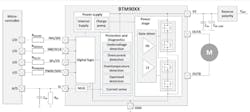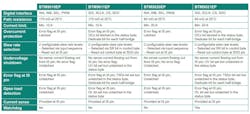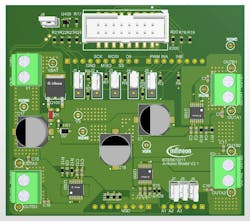Cost-Efficient 10/20-A Bridge Driver ICs Built for Automotive Apps
What you’ll learn:
- Infineon's MOTIX full-bridge family of 10- and 20-A drivers are suited for automotive applications.
- Devices can be paralled to double their current drive capability.
- A set of Arduino Uno evaluation shields along with code examples make prototyping quick and easy.
Infineon just announced a cost-optimized family of full-bridge ICs, comprising four product variants, tailored for brushed DC motor-control applications in the harsh automotive environment. Applications include automotive brushed DC motors, door modules, thermal management, body-control modules, zone-control modules, and most automotive inductive or resistive loads.
The company’s new BTM90xx products (Fig. 1) offer a high feature density to enable cost and space savings, and they come with ISO 26262 documentation to support functional-safety applications, if needed.
The product family’s key features include:
- Supply voltage range: 7-18 V, for transients 4.5-40 V
- BTM901X (datasheet) min current limit: 10 A, 5.2 A for 1 sec @ 85°C
- BTM902X (datasheet) min current limit: 20 A, 8.8 A for 1 sec @ 85°C
- PWM frequency up to 20 kHz
- SPI variants BTM9011/21 supporting daisy-chain operation
- Current sense on both high and low side
- 2 selectable slew rates
- Protections and diagnostics: Overcurrent, undervoltage, overtemperature, open load detection, cross-current protection
- Independent half-bridge mode (more flexibility)
- To double the current capability, parallelize OUTA and OUTB of the device
- TSDSO-14 (4.9 × 6.0 mm2) package with 11-mm2 exposed pad for enhanced thermal performance
- –40 to 150°C operating temperature range
- AEC-Q100 qualified (Grade 1)
The feature table below is useful for sorting out the feature sets against the MOTIX family part numbers (Fig. 2).
Evaluation Boards: Arduino Uno Shields
Infineon has taken an interesting approach to its evaluation boards for MOTIX in that they are Arduino Uno shields. The KIT_BTM9020/21 evaluation board contains three 20-A MOTIX full-bridge BTM90xx devices and an interface to the Arduino Uno. The BTM9020EP operates via direct interface, whereas BTM9021EP runs via SPI. The board design provides the flexibility to test different features of devices, though it’s not available at press time.
The KIT_BTM9010/11 Arduino Shield (user manual here), which is currently available, comes equipped with the 10-A MOTIX full-bridge ICs BTM9010EP and BTM9011EP (Fig. 3). It’s intended to help users evaluate hardware and software functionality.
The eval boards come with example Arduino code, which should make prototyping and evaluation very low risk in terms of eating up development and prototyping schedules. Other development tools include Infineon’s MOTIX Full Bridge IC Configuration Wizard, a SPICE model, a Power calculation tool (in Excel), and a Power dissipation tool, the Infineon Automotive Power Explorer. There’s also a TTM model available under NDA. PCB footprints and schematic symbols can be downloaded on Infineon’s website for Altium, Cadence, Eagle, and Mentor.
The 10-A parts are available at press time from Infineon and major distributors, with Infineon selling either of the two parts for $2.21 in single quantity. The 10-A eval board is currently in stock at $68.75 from distributors and Infineon.
AndyT's Nonlinearities blog arrives the first and third Monday of every month. To make sure you don't miss the latest edition, new articles, or breaking news coverage, please subscribe to our Electronic Design Today newsletter.




